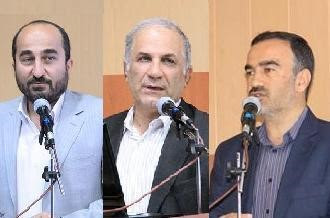The Sort-of-Secret University Behind Iran's Missile Program
One Iranian university that we think doesn’t get the
attention it deserves - perhaps because of its mouthful of a name – is Khaje
Nasir al-din Toosi Industrial University. Catchy right? We know it as KNTU.
This is a great acronym if you’re a fan of 1990s advertising campaigns for
French Connection. Based in Tehran, KNTU is an elite
engineering school that reportedly only admits the top 1% of those who take Iran’s
notoriously competitive university entrance exams.
That’s what you’ll read on Wikipedia anyway. What you won’t find there is the fact that KNTU is one of Iran’s most
important centers for missile research. Without KNTU-developed technology and
KNTU-schooled engineers, Iran’s missiles simply wouldn’t fly.
You don’t need to take our word for it. Today we’re going to
take you through some of the open source evidence that demonstrates KNTU’s key
role in advancing Iran’s missile program. We’ll also point out some evidence
that suggests KNTU is playing around with nuclear research as well. This might
warrant a visit from the international nuclear watchdog, the IAEA.
A good place to start is the KNTU alumni list. Probably the
university’s most famous graduate is Shahid Hassan Tehrani Moghaddam (حسن تهرانی مقدم), the infamous head of a secret Iranian ICBM project,
run by the IRGC. Moghaddam was killed in 2011 during a test of a malfunctioning rocket. Another former KNTU student is Darioush Rezaienejad (داریوش رضایینژاد), a
suspected member of Iran’s nuclear explosive-related research efforts who was
assassinated in 2011. Rezaienejad was admitted to KNTU as a PhD student but never completed his studies.
These two should give you a good idea of the sort of graduate
that KNTU aspires to produce.
The best place, though, to understand the nature and extent
of KNTU’s work on missile design and development is the university’s published
research, which is generally only available in Farsi. Let us help you out with
that! Redline has undertaken a review of Iranian scientific databases and has
come up with ten papers that by their titles alone make patently clear the sort
of missile-related research that goes on at KNTU.
Here they are (don't say I'm not good to you):
1. Conceptual Design of Solid Propellant Missile Side Boosters According to Collaborative Design Theory
2. Mathematical Modelling and Dynamic Simulation of an RD-180 Liquid Oxygen Motor Engine
3. Designing an Overhead Ballistic Missile Control System in the Active Section Using a PID Controller
4. Three-Dimensional Numerical Simulation of Cooling Recovery in a Liquid Fuel Rocket Engine
5. Conceptual Design Software for Multi-Stage (LVCD) Liquid Propellant Rocket with Multi-Parameter Approach
6. Calculation and Optimization of a Rocket Propellant Liquid Fuel Tank’s Mass System
7. Investigation of the Performance and Application of a Combustion Chamber in Missile and Space Propulsion Systems
8. Investigation of the Effect of Liquid Fuel Turbulence on the Dynamic Stability of a Ballistic Missile
9. Modelling the Effect of Baffles on Combustion Stabilization in Liquid Propellant Missiles
10. A Method of Simulation of a Cryogenic Liquid Propellant Engine
As you can see, KNTU’s work covers liquid and solid
propellant rocket motors, multi-stage systems, and aerodynamics – all critical
elements of missile design. These ten papers are, of course, the proverbial tip
of the iceberg: there are many more papers published by KNTU authors on missile
related topics. And, of course, the most sensitive research undertaken by KNTU
will likely never be published in the public domain. It will be
security-classified and provided only to customers in the IRGC and Iran’s Ministry of Defense (MODAFL - وزارت دفاع و پشتیبانی نیروهای مسلح).
It’s not just missile-related research that concerns us
about KNTU. You will forgive Redline for worrying just a little when a single
institution is investigating both potential nuclear weapon delivery systems and
nuclear material. Here’s an interesting paper we found where KNTU researchers
look at uranium contamination of groundwater. This kind of research often
uses small samples of uranium compounds. If that’s the case, that’s exactly the
kind of work that must be declared to the IAEA as part of Iran’s obligations
under the nuclear deal.
And speaking of nuclear weapons this is a KNTU
publication where two KNTU mechanical engineers describe the design and
construction of a device called an explosive-driven shock tube. A shock tube
like the one they describe can be used to study explosive blast effects for
legitimate conventional military purposes, such as testing the effects of
explosives against armor. But – this technology is also awfully close in design
to something called a gas gun, which simulates the shock waves
experienced inside a nuclear bomb as it begins imploding.
Mystifyingly, KNTU has not yet been put on the United States’
extensive sanctions list. We don’t expect this situation to remain for
too long. After all, finding evidence that KNTU is the hub of missile-related
research isn’t exactly rocket science.
To help out Googlers, KNTU is also known as Khajeh Nasir
Toos, K.N. Toosi, Khaje Nasiriddin Tusi, Khaje Nasi Reddin Toosi, Khaje Nasi R
Al Din Tusi, Nasir al-Din al-Tusi and probably a dozen other unpronounceable iterations
that help to explain why nobody outside of Iran talks about the place.








Comments
Post a Comment